(click on photos to enlarge image)
THE SIGNIFICANCE OF MOTE SPOON PIERCING
I have recently been made aware of misunderstandings in the
minds of some collectors of English silver plate concerning the
piercing of mote spoons which has led to the belief that these
little spoons were not entirely English in origin and it would
seem appropriate therefore to say a few words on this subject.
There is no evidence of the existence of mote spoons anywhere in
the world until they appeared in London in the late 17th century
when they were known as "long tea strainer spoons". Although
they were in use in connection with tea drinking for about a
century it has still not been established for certain how they
were used, but what is known is that the original examples were
utilitarian in design with nothing but simple holes drilled
through their bowls thus allowing the straining which their name
implied.
By the turn of the century these simple holes had given way to
quite decorative design and this was experimented with
throughout the 18th century. However to date no evidence has
been discovered to suggest that any of this experimentation
originated outside London although a few of these spoons were
made in America and some may even have been made in Dublin
(see note 1).
It seems likely that it was at the beginning of the 18th century
that specialist piercers began this experimentation and early in
the century mote spoons were produced which, although by
different makers, exhibit identical piercing suggesting that not
all makers did their own piercing. Fig I is of two mote spoons
made between 1697 and 1720 by different makers and it will be
seen that their piercing is not only identical but is of a very
high quality indicating the work of a specialist.
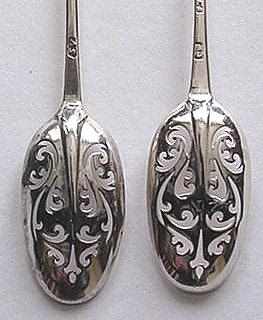 |
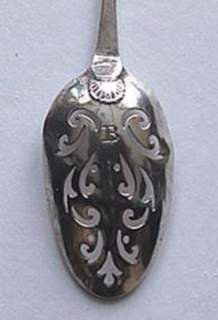 |
FIG. I
|
FIG.II
|
Examination of the patterns used on these early spoons shows
that these patterns became established and were used fairly
universally. Fig II is of a mote spoon of about 1737 that
exhibits very similar piercing, but not by a specialist,
combined with the shell heel that had become popular by then.
Both the quality of the piercing and its symmetry can indicate
that the work was executed by a specialist but not all makers
used the services of these specialists. Fig III is of two mote
spoons that were produced in the Harache workshop and must be
dated to about 1710. The quality of the piercing on these spoons
is sufficiently good that it too could have been done by a
specialist and the only reason for doubting this is that a
foliate motif has been used that is peculiar to the Haraches.
(note the engraved ‘stem’ leading to the leaf-like apertures on
either side of the bowls particularly noticeable on the left
hand spoon).
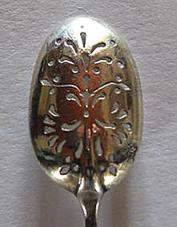
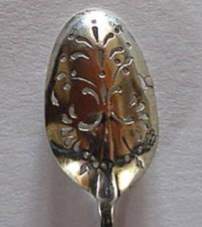 |
FIG. III
|
This quality of workmanship can lead to the belief that
specialist piercers have been used by makers when, in fact, they
had developed their own expertise. On such occasions it is only
by identifying a particular pattern of piercing with a
particular maker that it can be established that a mote spoon
was made in its entirety by one man. Fig IV is of two mote
spoons of the mid 18th century made by Francis Harache which,
like the earlier Harache examples, exhibit a foliate design and
this is peculiar to Francis showing that he and he alone was
responsible for these spoons.
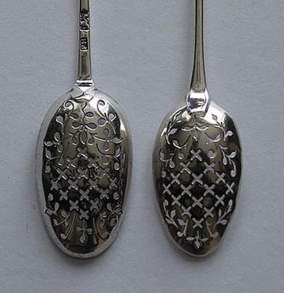 |
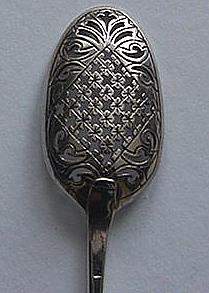 |
FIG. IV
|
FIG.V
|
It is also possible to establish that a spoon was made in
its entirety by one man, notwithstanding the outstanding quality of the
workmanship, by the decorative features it exhibits. Fig V is of
a spoon made by Samuel Key in about 1750 which has not only been
pierced in the standard way with the crosslets that had by then
become the norm but has been exquisitely engraved. This
engraving is unlikely to have been the work of a specialist
piercer although the man who made this spoon was undoubtedly a
specialist!
This quality of workmanship was not common to all mote spoon
makers who did their own piercing and this can sometimes lead to
a belief that a spoon is not English especially if the piercings
are not of a standard form. Fig VI is of three mote spoons that
are anything but standard and both the symmetry and quality of
workmanship leave much to be desired. They are, nevertheless,
all English mote spoons!
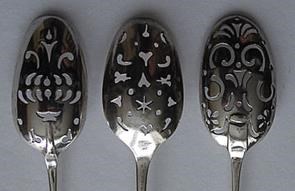
|
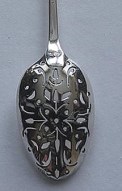 |
FIG. VI
|
FIG.VII
|
This lack of standardisation can add considerably to the
interest in collecting such spoons but there are pitfalls. Fig
VII is of a spoon that I have written about before. Both the
symmetry and the standard of workmanship are good showing that
the piercer exercised a good deal of expertise and the actual
patterns used are quite attractive. Beware however, do not be
misled by these features for this spoon is a converted teaspoon
and thus a fake so piercing alone cannot determine the
authenticity of a mote spoon.
It will be seen from the foregoing that the piercing on a mote
spoon is much more likely to indicate who made it, even if he
remains unidentified, than it is to indicate where it was made.
Notwithstanding the variable quality of the workmanship
exhibited in the piercing of these spoons, the wide variety of
design merely adds to the fascination of collecting them but one
must always beware of fakes.
ADDENDUM:
In writing about mote spoons in the past I have stated that they
were not common on the continent of Europe or in Scotland or
Ireland. I have now been made aware that there are very rare
examples of Irish mote spoons. Fig VIII.
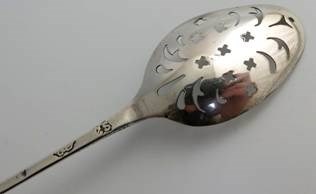 |
Fig VIII Mote spoon made
by Christopher Skinner and assayed in Dublin in
about 1753
(Image by kind permission of Woolley &
Wallis-Auctioneers of Salisbury)
|
David McKinley
- 2013 -
David McKinley devotes much of his time to
researching the history of silversmithing in England
with particular reference to hallmarking at the London
office. He writes for both The Silver Spoon Club of
Great Britain and The Silver Society.
David McKinley is the author of the book THE FIRST
HUGUENOT SILVERSMITHS OF LONDON
Information about the content of this book and the
discounted price applied to members of ASCAS is
available in
September 2011 Newsletter
|
|









